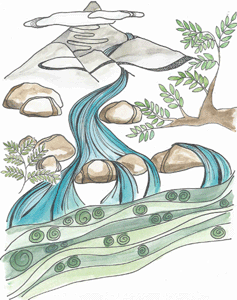 A Journey into the
A Journey into the
Practice and Philosophy of Yin Yoga
Guided by Bernie Clark

A common metaphor for the spiritual journey is climbing a mountain. We all start somewhere near the base of the mountain. Craning our necks to look up, we are inspired by its magnificence. Often the peak of the mountain is obscured, hidden by the clouds of ignorance, and we are not sure where we are headed. The paths are varied, and there are many ways to begin the long climb. Along the way, guides appear who know this or that particular part of the path, but we meet very few people, if any, who have actually been all the way to the top. We are told that, once we reach that lofty summit, called “Samadhi,” everything will become clear to us. We will be able to look out and see the entire world in a way we could never have imagined. We will be able to look at where we have come from, and see that all paths, as different and varied as they may be, lead to this one peak.
However, a peak is a small place. Not many can fit here, and no one can actually remain at this Summit of Samadhi. Even the most accomplished yogi must descend from time to time.
This metaphor is very yang in nature. It requires a lot of effort to climb a mountain, especially the Yang Mountain. People who do this we call yangsters. It is hard work. Yang refers to things that are higher and brighter, to actions that are more forceful and dynamic. For many people, yang is their favorite way to live, and the only way they know how to live. But it is not the only way. Yin always exists as a complement to yang. Yin refers to things that are lower and calmer, to actions that are passive and yielding. The spiritual practice has another metaphor that may be more appealing to many of us: the flow of a great river, the Yin River. Here we find the yinsters.
The journey we are about to embark upon is a yin journey: it is a trip down the Yin River, toward the universal ocean. At the dock, the Buddha is waiting, inviting us to board a ferryboat. The river will carry us; all we need to do is pay attention and steer. Occasionally we will have to manage a few rapids: no activity is ever completely yin, or completely yang. Even if we are climbing the Yang Mountain, there will be yin times to rest and admire the view. As we float down the Yin River, there will be yang bursts of activity and times when we need to make decisions. Occasionally the river will be broad and slow, and we will have time to investigate many interesting sights: these are our yinsights. At other times, the river will narrow and our pace will quicken. We will have less time to investigate the waters around us.
Along this journey down the Yin River, side trips will beckon to us: broad lakes and other rivers will appear. We will have the option to explore these new waters, or linger in one area for a more thorough investigation. Perhaps we will take up these options right away, or perhaps we will note them for some future investigation. The trip overall will be leisurely. As we journey, we will meet many other travelers. The river is broad and, unlike the tiny peak of the Yang Mountain, the Universal Ocean we are heading toward can accommodate everyone. We will, hopefully, come to appreciate the yin side of life, the easy pace of the river, and the breadth of our discoveries.
The journey begins with the very question that may have brought you to the pier of departure: What is Yin Yoga? Once you board our little ferryboat, your question will be addressed. The first part of the journey will show you some of the history of yoga in general and of Yin Yoga in particular. This will become a theme throughout the journey: many of our discoveries will apply, not just to the tributaries of Yin Yoga, but also to the broader, grander river of yoga. We will pass through waters where we will see our body reflected through different eyes, through different models. We will see ancient and modern views of our body mind. As we explore these views, we will also see the benefits yoga practice has for our body mind.
The Universal Ocean awaits us at the end our journey, but before we catch sight of these vast waters, we will see how to practice Yin Yoga. We will find some simple principles to guide our practice. A description of many of the most commonly used Yin Yoga postures, or asanas, will be provided, along with some suggested ways to build these postures into flows, and into a complete yoga practice. Around the final bend will be an exploration of how to move energy through physical practice, breath work, and meditation.
How, where and when the journey will end – will depend upon you.
The journey will begin with our first yinsight:
What is Yin Yoga?
(Next: What is Yin Yoga? )

 A Journey into the
A Journey into the